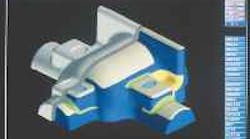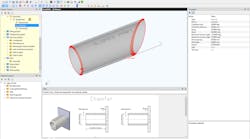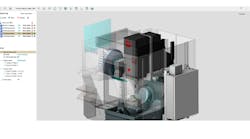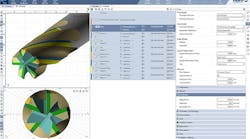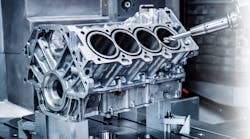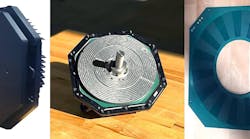Intelligent NC captures the user's knowledge of the machine process and recognizes the appropriate machining strategies.
While these two parts are geometrically different, a machinist recognizes that they are in fact machined using the same process. The colored regions show areas that would be machined using equivalent technology. Intelligent NC captures the machining process used on the first part, and automatically applies and adapts it to the second.
As the millennium approaches, CAM software developers have started to address the complete automation of the manufacturing process. Although they've solved many pieces of the puzzle — from macro capture, to generative NC, to automatic NC — no one has put the whole CAM story together in one package. Actually that is, until now.
Most attempts to automate started with simple 2.5-axis programs. These early attempts all focused on machining design "features." For a sculptured surface model, the promise of full 3-axis automation seemed hopeless, because in general, CAM software development has not kept pace with its CAD counterparts. However, the introduction of Intelligent NC has changed that. Intelligent NC holds the key to completely automating the manufacturing process by combining the modern CAM software technologies like manufacturing feature recognition (MFR), automatic NC (ANC), and knowledge-based machining (KBM) with complete knowledge of stock remaining (KSR).
Intelligent NC captures the user's knowledge of the machining process and recognizes the appropriate machining strategies. This new process plan automatically applies and adapts to any new geometry, in order to produce safe, efficient, high quality toolpaths. Intelligent NC promises to capture the manufacturing engineer's experience and knowledge to allow a novice machinist to apply this knowledge to new jobs — automatically.
Intelligent NC is not feature-based machining. This would restrict machining to the geometrical features the designer had used to model the part. These geometrical features have nothing to do with the optimal method in which the part should be machined. MFR, on the other hand, automatically recognizes machining features with technologically similar attributes like slope, horizon-tal/vertical areas, curvature, and bounded or unbounded volumes. Based on the way previous jobs were machined, the system will decide which machining strategy to apply. One must machine the part the way a machinist sees it, especially if the machinist needs to override or modify the automatic strategy selection. MFR will make the cutting strategy decision process automatic.
The model should not have to be a solid to take advantage of Intelligent NC. Models in the automotive industry can be solid, surfaces, or a hybrid model of the two technologies. In fact, Intelligent NC must apply to wireframe geometry or to geometry which started as a cloud of points. It shouldn't matter if the model is created native from within the CAD module of a particular package, or if the model is brought in from another system via IGES, VDA, STEP, or SAT. In fact, the CAD data source is irrelevant.
A faster machining process
ANC will provide companies with the tools to capture an entire machining process. The benefit is that the process can then be applied to technologically similar parts, cores, cavities, or electrodes. Furthermore, a "standard" is then established, forcing all similar parts/molds to be machined according to the most efficient and beneficial method. Once a library of machining strategies is in place, NC programming becomes a "one button" process. The learning curve shortens, allowing novice programmers to machine high quality molds fast, with complete safety. This technique captures the machining intent of top programmers, thereby capturing their knowledge.
A more efficient machining process
Knowledge engines optimize toolpaths and produce efficient NC code for the shop floor. With KBM, it is possible to eliminate extra cutting time, because systems actually analyze the geometry and determine regions to be machined with a similar milling strategy. KBM introduces additional toolpath movement or eliminates unnecessary motion to provide optimal material removal with good surface finish.
A safe machining process
KSR should not only calculate the stock remaining after each toolpath, it must use this information to optimize subsequent cutter movement. Toolpaths can also be optimized to account for high speed machining (HSM) techniques. The system will be able to fully gouge-check all cutter moves against the stock remaining as well as the part.
It has taken the CAM industry 20 years to catch up to the CAD industry. The advent of new algorithms to address MFR, ANC, KBM, and KSR will make Intelligent NC a reality. Early next century, several CAM software developers will be introducing this technology. For the mold-maker, these algorithms will let standards be applied in an automatic, fast, efficient, and safe manner. The worldwide shortage of moldmakers may well be addressed in these new technologies as they promise to shorten apprenticeship training.
Capturing the engineer's knowledge in a database will be the next technological leapfrog for which the CAD/CAM industry is already preparing.
